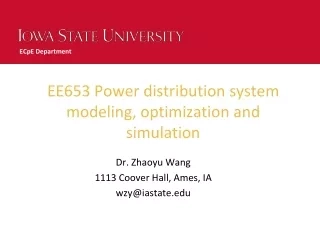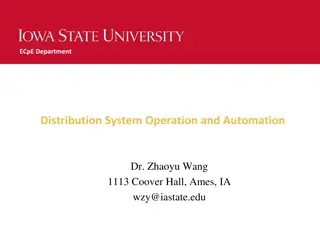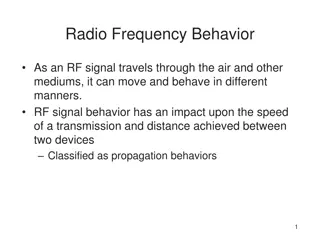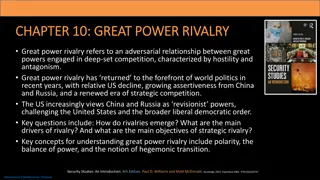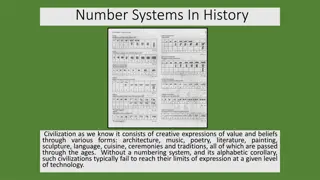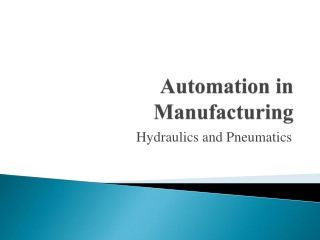Load Frequency Control in Power Systems
Electric power systems require Load Frequency Control (LFC) to maintain a uniform frequency, distribute load among generators, and manage tie-line interchange schedules. LFC detects frequency changes, generates real power commands to adjust torque, and ensures stability within specified limits. Reasons for constant frequency include motor speed dependence and equipment protection. Strategies and challenges in SingleArea Power Systems are addressed through conventional and automated control methods.
Download Presentation
Please find below an Image/Link to download the presentation.
The content on the website is provided AS IS for your information and personal use only. It may not be sold, licensed, or shared on other websites without obtaining consent from the author. Download presentation by click this link. If you encounter any issues during the download, it is possible that the publisher has removed the file from their server.
Presentation Transcript
JAIPUR ENGINEERING COLLEGE AND RESEARCH CENTRE Year & Sem - B.Tech III year, sem- VI Subject Power System-II Unit - III Presented by - Ms. Ritu Soni Designation - Assistant Professor Department- Electrical Engineering Ritu Soni ( Assistant Professor, EE ), JECRC, JAIPUR 1 1
Load Frequency control Introduction Reasons for constant frequency Methods of Load frequency control LFC problem in SingleArea Power System Load Frequency Control of TwoArea System Automatic Generation Control (AGC)
Introduction In an electric power system, Load Frequency Control (LFC) is a system to maintain reasonably uniform frequency, to divide the load between the generators, and to control the tie-line interchange schedules. The change in frequency is sensed when the rotor angle is changed. The error signals are transformed into real power command signal, which is sent to prime mover to call for an increment in the torque. The prime mover then brings change in the generator output by an amount which will change the values of within the specified tolerance.
Reasons for constant frequency The speed of the alternating current motors depends on the frequency of the power supply. There are situations where speed consistency is expected to be of high order. The accuracy of the electric clocks are dependent on the frequency of the supply. If the normal frequency is 50 Hertz and the system frequency falls below 47.5 Hertz or goes up above 52.5 Hertz then the blades of the turbine are likely to get damaged so as to prevent the failing of the generator. Due to the subnormal frequency operation the blast of the ID and FD fans in the power stations get reduced and thereby reduce the generation power in the thermal plants.
Fig. Schematic diagram of load frequency and excitation voltage regulators of a turbo- Generator
LFC problem in SingleArea Power System The load frequency control strategies have been suggested based on the conventional linear Control theory. These controllers may be unsuitable in some operating conditions due to the complexity of the power systems such as nonlinear load characteristics and variable operating points. Under normal operating condition controller are set for small changes in load demand without voltage and frequency exceeding the pre specified limits. If the operating condition changes by any cause, the controller must be reset either manually or automatically. The objective of load frequency controller is to exert the control off frequency and at the same time real power exchange via outgoing transmission line.
Turbine Speed Governing System The speed governor is the main primary tool for the load frequency control (LFC). Figure shows a schematic arrangement of a speed governing system used on steam turbines to control the output of the generator to maintain constant frequency. The speed governing system consists of the following parts . 1) Speed governor 2) Linkage mechanism 3) Hydraulic amplifier 4) Speed changer
1.Fly ball speed governor This is the heart of the system which senses the change in speed (frequency). As the speed increases the fly balls move outwards and the point B on linkage mechanism moves downwards. The reverse happens when the speed decreases. 2.Hydraulic amplifier It comprises a pilot valve and main piston Low power level pilot valve movement is converted into high power level piston valve movement. This is necessary in order to open or close the steam valve against high pressure steam.
3. Linkage mechanism ABC is a rigid link pivoted at B and CDE is another rigid link pivoted at This link mechanism provides a movement to the control valve in proportion to change in speed. It also provides a feedback from the steam valve movement 4. Speed changer It provides a steady state power output setting for the turbine. Its downward movement opens the upper pilot valve so that more steam is admitted to the turbine under steady conditions (hence more steady power output). The reverse happens for upward movement of speed changer.
Model of Speed Governing System Assume that the system is initially operating under steady conditions the linkage mechanism stationary and pilot valve closed, steam valve opened by a definite magnitude, turbine running at constant speed with turbine power output balancing the generator load. Let the operating conditions be characterized by We shall obtain a linear incremental model around these operating conditions. Let the point A on the linkage mechanism be moved downwards by a small amount yA. It is a command which causes the turbine power output to change and can therefore be written as
.(1) where PC is the commanded increase in power. The command signal PC (i.e. yE) sets into motion a sequence of events the pilot valve moves upwards, high pressure oil flows on to the top of the main piston moving it downwards; the steam valve opening consequently increases, the turbine generator speed increases, i.e. the frequency goes up. Let us model these events mathematically. Two factors contribute to the movement of C: .(3)
The movement yD depending upon its sign opens one of the ports of the pilot valve admitting high pressure oil into the cylinder thereby moving the main piston and opening the steam valve by yE. Certain justifiable simplifying assumptions, which can be made at this stage, are: Inertial reaction forces of main piston and steam valve are negligible compared to the forces exerted on the piston by high pressure oil. Because of (i) above, the rate of oil admitted to the cylinder is proportional to port opening yD. The volume of oil admitted to the cylinder is thus proportional to the time integral of yD,. The movement yE is obtained by dividing the oil volume by the area of the cross-section of the piston. Thus .(4)
It can be verified from the schematic diagram that a positive movement yD causes negative (upward) movement yE accounting for the negative sign used in above Eq. Taking the Laplace transform of above Eqs. (2),(3), and (4) we get .(5) .(6) .(7) Eliminating YC(s) and YD(s), we can write .(8)
Where Equation (8) is represented in the form of a block diagram in Fig.
Adjustment of Governor Characteristics The control of system frequency and load depends upon the governor of the prime movers. The below figure shows the characteristics of the speed governor system
For stable operation of generator ,the governors are designed to permitt the speed to drop as the load is increased . Then slop of the curve represent the speed regulation R. Governors typically have a speed regulation of 5-6% from zero to full load.
Where NL=Steady state speed at No-Load FL =Steady state speed at full load 0 =Rated speed If two or more alternators with droping govenor characteristics are connected to a power system there will be unique frequency at which they will share a load change.
Assme ,two generator units with droping characteristics as shown in above figure. Let the initial frequency of both the unit is f with power output P1 and P2 when a load increases to P it causes the units to slow down/. The governor increases the output until they reach a new common operating frequency f.
Load Frequency Control of TwoArea System An extended power system can be divided into a number of load frequency control areas interconnected by means of tie lines. Without loss of generality two area case connected by tie-line is considered.The control objectives are as follows: (1)Each control area as for as possible should supply its own load demand and power transfer through tie line should be on mutual agreement. (2) Both control areas should controllable to the frequency control.
A two area system consists of two single area systems connected through a power line called tie-line. Each area feeds its user pool, and the tie line allows electric power to flow between the areas, because both areas as well as the power flow on the tie-line. For the same reason, the control system of each area needs information about the transient situation in both areas to bring the local frequency back to its steady state value. Information about the local area is found in the tie line power fluctuations. Therefore, the tie-line power is sensed, and the resulting tie-line power signal is fed back into both areas. It is conveniently assumed that each control area can be represented by an equivalent turbine, generator and governor system.
Automatic Generation Control Sometimes, load on the system is increased suddenly then the turbine speed drops before the governor can adjust the input of the steam to the new load. As the change in the value of speed diminishes, the error signal becomes smaller and the position of the governor get closer to the point required to maintain the constant speed. One way to restore the speed or frequency to its nominal value is to add an integrator on the way. As the load of the system changes continuously the generation is adjusted automatically to restore the frequency to the nominal value. This scheme is known as automatic generation control. In an interconnected system consisting of several pools, the role of the AGC is to divide the load among the system, stations and generators so as to achieve maximum economy and reasonably uniform frequency.
Contents Introduction Importance of voltage control Methods of voltage control Shunt compensation Series capacitor Synchronous condenser Tap changing transformer Auto transformer tap changing Booster transformer
Introduction Transmission of power from generating station to consumers. Constant voltage for satisfactory operation. Variation cause unpredictable operation or mal functioning. Cause : change in load at supply side. Load , voltage due to synchronous impedence, transmission impedence, transformer impedence, feeders and distributors. Prescribe limits : +- 6% of declared voltage Voltage regulating device at suitable places. voltage drop in alternator
Importance of Voltage Control Lighting load : Lamp characterisic is very sensitive to change in voltage. below limit 20% Above limit 50% in life of lamp. in illumination power. Induction motor : in voltage in voltage saturation of pole reduces starting torque. Distribution Transformer : Due to heating, rating reduces.
Location of voltage control Equipments Used at more than one point due to Desirable drop in transmission and distribution. Dissimilar load characteristics. Individual means of voltage control for each circuit. Devices used at Generating station Transformer station Feeders if drop exceeds the limit
Methods of Voltage Control 1. Shunt compensation 2. Series capacitor 3. Synchronous condenser 4. Tap changing transformer 5. Auto transformer tap changing
1. Shunt Compensation Shunt Reactor : Used to compensate effect line capacitance limit voltage rise on open circuit or light load increases effective ZC They are connected either: directly to the lines at the ends Tertiary windings In long lines to overcome ferranti effect. Connected to bus bar without C.B for switching. easily switched as VAR vary.
Shunt Capacitor : Supply leading reactive power and boost the voltage as loading of current reduces. Switching substation inductive current of lower P.F. They are connected either: H.V . bus Tertiary winding of transformers Advantage : low cost and flexibility of installation. Disadvantage : Q is proportional to (voltage)^2. So output reduces. inductive load absorb
2. Series Compensation Series capacitor : Connected in series with line. Used to reduce inductive reactance of line so reduction of I2X loss characteristic impedance ZC Reactive power produced increases with increasing power transfer. Application : improve power transfer capacity. voltage regulation
3. Synchronous Condenser A synchronous machine running without a prime mover or a mechanical load Depending on field excitation, it can either absorb or generate VARs With a voltage regulator, it can automatically adjust VAR to maintain constant voltage Started as an induction motor and then synchronized Normally connected to tertiary windings of transformers Unlike a SVC, a synchronouscondenser has an internal voltage Speed of response not as fast as that of an SVC
4. Tap Changing Transformer Off load Tap changing transformer : Position of tap number of turns Stud 1 : min value Stud 5 : max value Light load primary voltage = alternator voltages and movable arm is placed at stud 1. Load drop so movement of stud. output voltage.
On load Tap changing transformer : widely used so no interruption of supply voltage Secondary divided into two parallel path so current divided. Tap changing operation is performed one after other. Disadvantages : Voltage surge due to high voltage drop. Num of tapings = 2 * voltage steps.
5.Auto Transformer Mid tapped auto transformer is used. Connected with one side of line, divided into two parts. Odd switches and even switches Normal operation no drop Tap changing high drop control by reactor. large circulating current flow
















